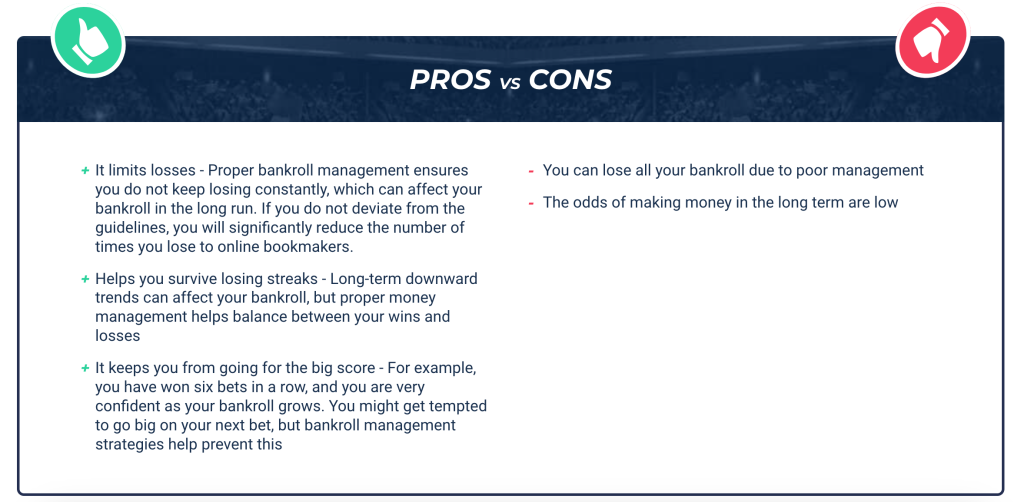
For many, sports betting serves as a leisure activity, yet there exists a substantial number who aim to elevate it to a professional level, eyeing significant financial returns. If you’re aspiring to become a professional bettor, mastering bankroll management is crucial. Here’s an in-depth look into the concept of bankroll management and its pivotal role in sports betting.
Understanding Bankroll Betting Management
Initially, it’s vital to grasp what ‘bankroll’ refers to—it’s the sum of money a sports bettor dedicates to wagering activities. Adhering to the principle of never risking more than you can afford to lose is foundational in sports betting.
Effective bankroll management begins with the decision of how much money to set aside for betting, followed by establishing personal rules for fund allocation and usage in sports betting.
The essence of bankroll management lies in focusing on two main elements: units and bet tracking. Employing various management strategies can help you tailor your bankroll to your betting objectives, enhancing your chances of success and mitigating financial losses. This approach is advisable for both novice and experienced bettors.
The Importance of Bankroll Management
Achieving success in sports betting is not only about understanding the sports but also mastering how to manage your finances. Proper bankroll management can dramatically influence your betting outcomes by limiting potential losses and helping you manage through losing streaks without depleting your funds. The key benefits of a robust bankroll management strategy include:
- Reducing the risk of losing your entire betting fund
- Deterring impulsive decisions for large, risky bets
- Providing a buffer to withstand several losses without financial ruin
Establishing Your Starting Bankroll
Determining your initial bankroll is the first step in bankroll management. This amount should be money that, if lost, will not affect your overall financial stability. The ideal starting point varies based on your financial situation but should be an amount you are comfortable losing.
Optimizing Your Wager Size
Once your total bankroll is set, the next step is to decide how much to wager per bet. For conservative bettors, 1%-2% of the bankroll per bet is standard; average bettors might opt for 3%, and more aggressive bettors might consider 4%-5%. This strategy helps in pacing your bets and ideally positions you for gradual profit accumulation rather than quick gains.
Best Practices in Bankroll Management
To optimize your sports betting endeavors, adhere to these practices:
- Use Units: This standardizes your bets relative to your bankroll, making it easier to track and compare betting outcomes without bias.
- Track Your Bets: Monitoring your betting history is essential to evaluate your betting strategies and understand which types of bets are most beneficial.
- Avoid Emotional Betting: Decisions driven by emotion can lead to poor betting choices. Always bet based on analysis rather than allegiance.
- Leverage Data for Smart Bets: Inform your betting decisions with historical data and performance analytics to place well-founded bets.
Bankroll management is not just a betting strategy but a disciplined approach to gambling that can lead to a profitable and sustainable sports betting career. Always prioritize setting aside money specifically for betting and base your betting amounts on a clear understanding of your financial limits and betting strategy.
Bankroll Management Strategies in Sports Betting
Sports betting does not require a uniform stake for each game. In this guide, we’ll explore various bankroll management strategies that can enhance your betting approach. From the widely-used fixed stake method to more dynamic models like the variable stake, each strategy offers unique benefits tailored to different betting styles.
Fixed Stake Strategy
The fixed stake, or fixed unit model, is a common and straightforward method where you wager the same number of units across all your bets. This consistency helps manage your betting without the influence of emotional swings or varying confidence levels.
Variable Stake Strategy
In contrast, the variable stake strategy adjusts your wager based on the perceived value of each bet. This method allows you to allocate more funds to bets you deem to have a higher potential return, optimizing your investments based on calculated risk assessments.
Flat Betting Model
A highly recommended approach for long-term stability is the flat betting model. This involves betting a single unit per wager without fluctuating your bet size based on confidence or odds. This model is ideal for maintaining a steady betting pace and can be adapted to either a ‘win’ method or a ‘risk’ method depending on your comfort level.
Percentage Model
The percentage model enhances the fixed unit system by adjusting your stake based on a percentage of your total bankroll. For instance, if you start with a £1,000 bankroll at 2% per unit, your initial bet would be £20. This stake will increase or decrease as your bankroll changes, allowing you to capitalize on winning streaks and minimize losses during downturns.
Potential Return Model
Focusing on potential returns rather than fixed units, this model adjusts your bet size to aim for a consistent unit gain per bet, regardless of the odds. This strategy particularly favors betting on favorites, recognizing their higher likelihood of winning, and adjusting stakes accordingly to maximize returns.
Popular Bankroll Management Systems
Kelly Criterion
This system refines your betting strategy by calculating the optimal stake based on your confidence level and the probability of winning. The formula used in the Kelly Criterion helps determine the ideal percentage of your bankroll to wager, enhancing your profit potential while controlling risk.
D’Alembert Strategy
Named after the 18th-century thinker Jean le Rond d’Alembert, this strategy uses a simple algebraic increase or decrease in your bet size based on previous outcomes. It’s particularly suited for events with odds greater than 2.0 and ensures that your betting remains within a safe range of your total bankroll.
Oscar Grind Strategy
This positive progression strategy aims to achieve a single unit of profit per betting cycle. By maintaining a consistent bet size until a win, and slightly increasing the stake during a winning streak, the Oscar Grind strategy focuses on small, incremental gains that can accumulate over time.
Fibonacci Strategy
Based on the famous Fibonacci sequence, this model involves increasing your bet size according to the sequence after a loss and stepping back two levels after a win. This method helps manage losses and leverage wins effectively.
Risks Associated with Bankroll Management
While these strategies can help mitigate some risks, they are not foolproof. Betting large percentages can deplete your bankroll quickly during a losing streak, while overly conservative betting might result in minimal profits. It’s essential to evaluate your risk tolerance and adjust your betting strategy accordingly. Here’s a brief overview of different risk levels:
- Low Risk (0% – 2%): Safest option, resulting in lower profits but minimal risk of depleting your bankroll.
- Moderate Risk (0% – 4%): Offers a balance between risk and potential returns, suitable for more experienced bettors.
- High Risk (0% – 5%): Targets those who are willing to accept higher risks for potentially greater rewards.
Through these diverse bankroll management strategies and systems, bettors can find a method that best suits their betting style and financial goals, leading to a more structured and potentially profitable betting experience.

Sports Betting Bankroll Management FAQ
Navigating the world of sports betting can be complex, especially when it comes to managing finances. Below, we address frequently asked questions that help bettors maintain a healthy bankroll and optimize their betting strategies.
❔ How Much Of My Bankroll Should I Bet With?
For newcomers, it’s advisable to bet between 1% and 2% of your bankroll per wager. More experienced bettors may choose to risk between 1% and 3%, depending on their confidence and betting strategy.
💶 How Do I Choose A Bank Management System?
Selecting the right bankroll management system depends on your personal betting preferences and the sports you are most interested in. It’s important to adopt a system that aligns with your risk tolerance and financial goals. Review various strategies and choose one that provides stability and growth potential.
💳 Do I Need To Keep Track Of Sports Bets In Bankroll Management?
Absolutely. Tracking your bets is crucial for effective bankroll management. Use a spreadsheet to record the details of each bet, including wins and losses. This data is vital for adjusting your betting strategies and understanding your betting patterns.
🤔 What Is A Stop-Loss Limit?
A stop-loss limit is a predefined amount you are prepared to lose within a specific timeframe before ceasing any further betting. This critical control helps preserve your bankroll and fosters disciplined betting habits.
❔ Does The Type Of Bet Affect The Size Of The Bankroll?
Yes, the type of bet can significantly influence your bankroll. Riskier bets may potentially drain your bankroll quicker, so it’s essential to make informed and prudent bets based on your bankroll’s size to sustain your betting activities longer.
🏆 What Is The Most Reliable Bank Management Strategy?
The flat betting system is considered one of the most reliable strategies. This method involves betting a consistent amount—typically between 1% and 5% of your bankroll—on every game, which helps mitigate large fluctuations in your bankroll.
💶 How Do I Calculate Profit?
To calculate potential winnings, use the formula: Odds (in decimals) x Stake = Winnings. Subtract the stake from the winnings to find the profit. Most online betting platforms offer tools like a betting odds calculator to simplify this process for you.
💳 How Much Can I Make As A Sports Bettor?
Your potential earnings as a sports bettor depend largely on the betting site you use and the strategies you implement. By adhering to sound bankroll management principles and employing effective betting strategies, you can maintain a healthy bankroll and increase your chances of profitability.
These FAQs provide a solid foundation for anyone looking to improve their sports betting skills through disciplined bankroll management. Whether you’re a beginner or an experienced bettor, these guidelines can help you make informed decisions and potentially increase your success in sports betting.







